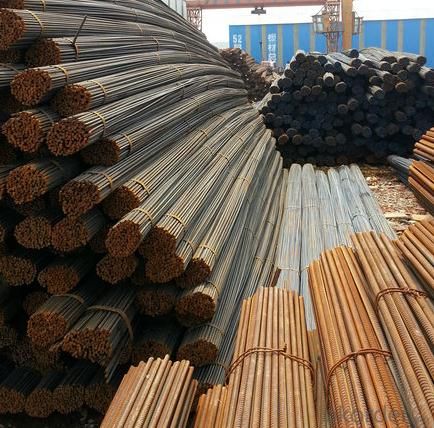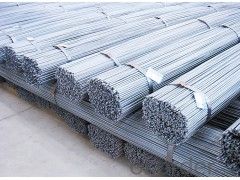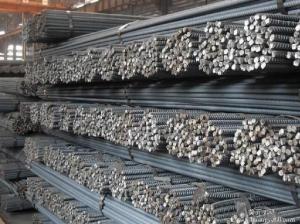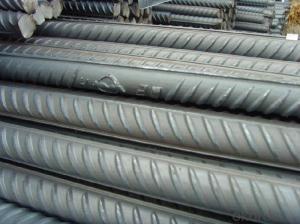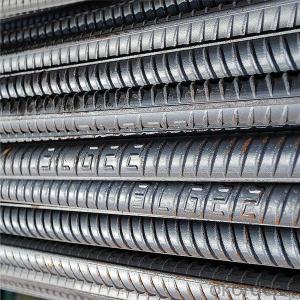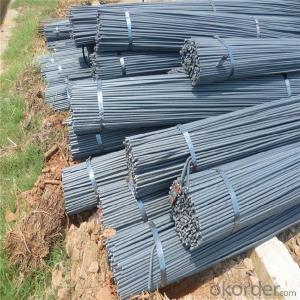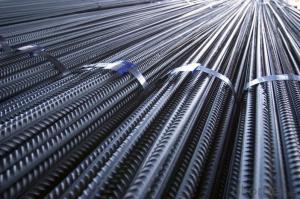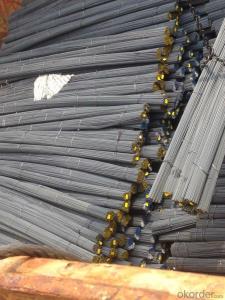Deformed steel bar deformed steel bar for construction
- Loading Port:
- Tianjin
- Payment Terms:
- TT OR LC
- Min Order Qty:
- 10000 m.t.
- Supply Capability:
- 100000 m.t./month
OKorder Service Pledge
OKorder Financial Service
You Might Also Like
Specification
OKorder is offering high quality deformed steel bar deformed steel bar for constructionat great prices with worldwide shipping. Our supplier is a world-class manufacturer of steel, with our products utilized the world over. OKorder annually supplies products to European, North American and Asian markets. We provide quotations within 24 hours of receiving an inquiry and guarantee competitive prices.
Product Applications:
Deformed steel bar deformed steel bar for construction for construction are ideal for structural applications and are widely used in the construction of buildings and bridges, and the manufacturing, petrochemical, and transportation industries.
Product Advantages:
OKorder's deformed steel bar are durable, strong, and resist corrosion.
Main Product Features:
· Premium quality
· Prompt delivery & seaworthy packing (30 days after receiving deposit)
· Corrosion resistance
· Can be recycled and reused
· Mill test certification
· Professional Service
· Competitive pricing
Product Specifications:
Specifications of Deformed Steel Bar:
Standard | GB | HRB335, HRB400, HRB500 | |
UK | G460B, B500A, B500B,B500C | ||
USA | GR40, GR60 | ||
Diameter | 6mm,8mm,10mm,12mm,14mm,16mm,18mm,20mm, 22mm,25mm,28mm,32mm,36mm,40mm,50mm | ||
Length | 6M, 9M,12M or as required | ||
Place of origin | Hebei, China mainland | ||
Application | building,construction,road,bridge etc | ||
Brand name | DRAGON | ||
Theoretical weight and section area of each diameter as below for your information:
Diameter(mm) | Section area (mm²) | Mass(kg/m) |
6 | 28.27 | 0.222 |
8 | 50.27 | 0.395 |
10 | 78.54 | 0.617 |
12 | 113.1 | 0.888 |
14 | 153.9 | 1.21 |
16 | 201.1 | 1.58 |
18 | 254.5 | 2.00 |
20 | 314.2 | 2.47 |
22 | 380.1 | 2.98 |
25 | 490.9 | 3.85 |
28 | 615.8 | 4.83 |
32 | 804.2 | 6.31 |
36 | 1018 | 7.99 |
40 | 1257 | 9.87 |
50 | 1964 | 15.42 |
Usage and Applications of Deformed Steel Bar:
Deformed bar is widely used in buildings, bridges, roads and other engineering construction. Big to highways, railways, bridges, culverts, tunnels, public facilities such as flood control, dam, small to housing construction, beam, column, wall and the foundation of the plate, deformed bar is an integral structure material. With the development of world economy and the vigorous development of infrastructure construction, real estate, the demand for deformed bar will be larger and larger..
Packaging & Delivery of Deformed Steel Bar:
Packaging Detail: products are packed in bundle and then shipped by container or bulk vessel, deformed bar is usually naked strapping delivery, when storing, please pay attention to moisture proof. The performance of rust will produce adverse effect.
Each bundle weight: 2-3MT, or as required
Payment term: TT or L/C
Delivery Detail: within 45 days after received advanced payment or LC.
Label: to be specified by customer, generally, each bundle has 1-2 labels
Trade terms: FOB, CFR, CIF
Deformed Steel Bar in Coil
Produce Line of Deformed Steel Bar
Q1: How soon can we receive the product after purchase?
A1: Within three days of placing an order, we will begin production. The specific shipping date is dependent upon international and government factors, but is typically 7 to 10 workdays.
Q2: What makes stainless steel stainless?
A2: Stainless steel must contain at least 10.5 % chromium. It is this element that reacts with the oxygen in the air to form a complex chrome-oxide surface layer that is invisible but strong enough to prevent further oxygen from "staining" (rusting) the surface. Higher levels of chromium and the addition of other alloying elements such as nickel and molybdenum enhance this surface layer and improve the corrosion resistance of the stainless material.
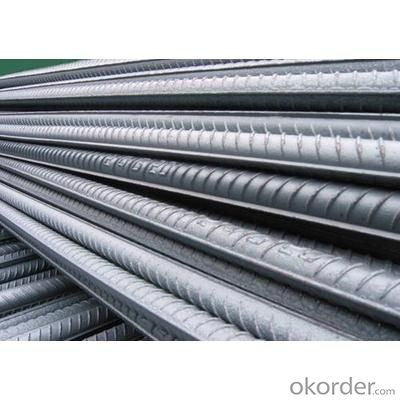

- Q: What is the typical weight of a steel rebar?
- The typical weight of a steel rebar varies depending on its size and length. However, a commonly used steel rebar, such as a #4 rebar, typically weighs around 9.5 pounds per foot or 14.2 kilograms per meter.
- Q: What is the role of steel rebars in preventing cracks in concrete structures?
- The role of steel rebars in preventing cracks in concrete structures is to provide reinforcement and increase the structural integrity of the concrete. By adding steel rebars, the concrete is better able to resist tensile forces that can cause cracking. The rebars act as a skeleton, distributing and absorbing the stresses placed on the concrete, thereby minimizing the formation of cracks and enhancing the overall durability of the structure.
- Q: Can steel rebars be used in the construction of water treatment plants?
- Yes, steel rebars can be used in the construction of water treatment plants. Steel rebars are commonly used in reinforced concrete structures, including water treatment plants, to provide strength and durability to the overall construction. The rebars help to reinforce the concrete and provide structural support, making them suitable for the rigorous demands and environmental conditions of water treatment plants.
- Q: What is the recommended lap length for steel rebars in concrete joints?
- The recommended lap length for steel rebars in concrete joints is typically specified by structural engineers and can vary depending on factors such as the diameter of the rebar, the type of concrete being used, and the desired level of structural integrity. It is important to consult the relevant building codes and engineering standards for specific guidelines and requirements.
- Q: Why is the price of screw steel affected by iron ore and coal?
- Just now the manufacturing needs to consume iron ore and gas energy, the cost goes up, the price certainly changes
- Q: How are steel rebars transported to the construction site?
- Various methods are employed for the transportation of steel rebars, also known as reinforcing bars, to construction sites. One commonly used approach involves the use of trucks. The rebars are loaded onto flatbed trucks or trailers and firmly secured with straps or chains to prevent any shifting during transit. These trucks are specially designed to withstand the weight and length of the rebars, boasting robust frames and loading mechanisms. Another method is rail transportation. Steel rebars can be loaded onto rail cars, either on flatcars or in specialized containers, and transported to the construction site. This method proves particularly advantageous for long-distance transportation, as it offers a more cost-effective and efficient solution for large quantities of rebars. For construction projects situated near waterways, the transportation of rebars can also be accomplished by sea or barge. The rebars are loaded onto ships or barges and properly secured to prevent any damage or movement during transit. This method is commonly employed for projects necessitating substantial quantities of rebars or for construction sites located on islands or in coastal areas. Upon arrival at the construction site, cranes or forklifts are typically utilized to unload the steel rebars. These rebars are then either stored in designated areas or immediately employed for reinforcement in the construction process. It is of utmost importance to handle the transportation of rebars with caution, as this ensures their structural integrity and guards against potential accidents or damage during transit.
- Q: Why can not the finish thread steel be welded?
- This is generally superior to alloy steel. Carbon content is relatively high, poor weldability, welding conditions are very demanding, but also produce high temperature welding, it is easy to destroy the original material performance. So, under normal circumstances, on-site welding is not allowed.
- Q: Are steel rebars prone to expansion and contraction?
- Yes, steel rebars are prone to expansion and contraction due to changes in temperature.
- Q: How do steel rebars impact the durability of concrete structures?
- The durability of concrete structures is significantly influenced by steel rebars. Adding steel rebars improves the strength and overall performance of concrete, making it more resistant to various external forces and extending its lifespan. To begin with, steel rebars offer structural reinforcement to concrete structures. Concrete has relatively low tensile strength, making it susceptible to cracking and failure under tensile stresses. By incorporating steel rebars into the concrete, these stresses are effectively distributed throughout the structure, preventing the formation of cracks and enhancing its load-bearing capacity. This reinforcement ensures that the concrete structure can withstand the forces it experiences, whether from gravity, wind, earthquakes, or other external factors. Additionally, steel rebars play a vital role in corrosion prevention in concrete structures. Concrete is highly alkaline, creating a protective environment for embedded steel. However, factors like moisture exposure, chloride ions, and carbonation can break down this protective layer over time, leading to steel corrosion. Corrosion weakens the rebars and causes the surrounding concrete to crack and spall, compromising the structure's durability. By using steel rebars with appropriate coatings or stainless steel, the risk of corrosion is significantly reduced, enhancing the structure's longevity and durability. Furthermore, steel rebars contribute to the durability of concrete structures by providing dimensional stability. Concrete tends to shrink and expand due to temperature and moisture changes, which can result in cracking and deformation. Incorporating steel rebars helps minimize these movements by providing restraint and stabilizing the structure, preventing excessive cracking and maintaining its integrity over time. In conclusion, steel rebars play a crucial role in enhancing the durability of concrete structures. They provide structural reinforcement, prevent corrosion, and ensure dimensional stability. By incorporating steel rebars into concrete, structures become stronger, more resistant to external forces, and have an extended lifespan. This ultimately leads to safer and more durable buildings and infrastructure.
- Q: What is the carbon content of thread steel?
- It is understood that carbon is the main element determining the performance of steel, because changes in carbon content directly lead to changes in crystal structure. With the increase of carbon content, the strength and hardness of the threaded steel increase, while the plasticity and toughness decrease. When the carbon content is more than 1%, the strength of the rebar decreases. The increase of carbon content also reduces the weldability and corrosion resistance of steel, and increases the cold brittleness and aging tendency of steel.
Send your message to us
Deformed steel bar deformed steel bar for construction
- Loading Port:
- Tianjin
- Payment Terms:
- TT OR LC
- Min Order Qty:
- 10000 m.t.
- Supply Capability:
- 100000 m.t./month
OKorder Service Pledge
OKorder Financial Service
Similar products
Hot products
Hot Searches
Related keywords




